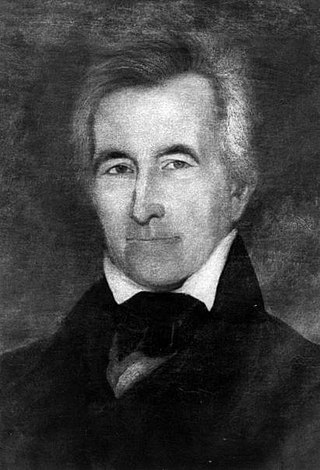Related Research Articles

Duplin County is a county located in the U.S. state of North Carolina. As of the 2020 census,the population was 48,715. Its county seat is Kenansville.

Cornelius Harnett was an American Founding Father,politician,merchant,plantation owner,and slaveholder from Wilmington,North Carolina. He was a leading American Revolutionary statesman in the Cape Fear region,and a delegate for North Carolina in the Continental Congress from 1777 to 1779 where he signed the Articles of Confederation. Cornelius Harnett is the namesake of Harnett County,North Carolina.

Moses Waddel was an American educator and minister in antebellum Georgia and South Carolina. Famous as a teacher during his life,Moses Waddel was author of the bestselling book Memoirs of the Life of Miss Caroline Elizabeth Smelt.

William Lee Davidson (1746–1781) was an officer in the North Carolina militia and Continental Army during the American Revolutionary War. He was born in Pennsylvania and moved with his family to Rowan County,North Carolina in 1750. He was killed at the Battle of Cowan's Ford.

Benjamin Rice Lacy served as North Carolina Commissioner of Labor from 1893–1897 and 1899–1901,and as North Carolina State Treasurer from 1901–1929. Lacy died one month after taking office for his eighth term as Treasurer.

Daniel Harvey Hill Jr. (1859–1924) was an American educator and the third chancellor of North Carolina State University. D. H. Hill Library on NCSU's campus is named in his honor.
Drury Lacy was a vice president and the acting president of Hampden–Sydney College from 1789 to 1797.

Jonathan Peter Cushing was the fifth president of Hampden–Sydney College.
John Lycan Kirkpatrick served as President of Davidson College from 1860 to 1866. Previously a minister from Virginia and formally educated at Hampden-Sydney College and Union Theological Seminary,Kirkpatrick entered the presidency on the eve of the American Civil War,which postponed Davidson's plans for growth and development. Kirkpatrick tasked with maintaining the financial solvency of the college and did so throughout the war.
Robert Hall Morrison was the first president of Davidson College. Morrison,originally from Cabarrus County,North Carolina,enrolled at the University of North Carolina at Chapel Hill,eventually graduating second in the class,behind future President James K. Polk. After graduating,Morrison entered the ministry before being appointed as president of Davidson. Morrison taught mathematics and science courses at the college. After a year as president,a typhoid fever epidemic swept through the area,taking two of his children. Morrison would later become ill and resign from the position in 1840,eventually retiring in 1849.
Samuel Williamson was the second president of Davidson College. After graduating from the University of South Carolina,Williamson entered the ministry. He arrived at Davidson in 1839 as a professor and then was appointed as president in 1841,becoming the longest serving president of the college during the 19th century. While president,Williamson steered the college through financial uncertainty while also building the Eumenean and Philanthropic Halls.

John Bunyan Shearer (1832–1919) was the eighth president of Davidson College.

Henry Louis Smith (1859–1951) was the ninth president of Davidson College and the first president to not be an ordained Presbyterian minister.
William Joseph Martin Jr. was the tenth president of Davidson College,being installed as president in 1912. Martin,the son of a Confederate veteran who was also a professor at Davidson,graduated from Davidson in 1888. After receiving advanced degrees from the University of Virginia and further instruction at Johns Hopkins University,Martin eventually found his way back to Davidson as a chemistry professor.

David Grier Martin Sr. was the 13th president of Davidson College. A graduate of Davidson College,class of 1932,he served as college treasurer under President Cunningham. He was forty-eight years old when he accepted the presidency of Davidson. A native of Covington,Georgia,Martin attended Emory University for graduate studies.
Samuel Reid Spencer Jr. was an American academic administrator who served as the 14th president of Davidson College from 1968 to 1983.

The Third North Carolina Provincial Congress was the third of five extra-legal unicameral bodies that met between 1774 and 1776 in North Carolina. They were modeled after the colonial lower house. These congresses created a government structure,issued bills of credit to pay for the movement,and organized an army for defense,in preparation for the state of North Carolina. These congresses paved the way for the first meeting of the North Carolina General Assembly on April 7,1777 in New Bern,North Carolina.

Constance Hill Marteena was an American librarian and author,known for her bibliographies about Black women.

James Spencer Love,also known as J. Spencer Love,was an American industrialist,textile manufacturer and president of chairman of Burlington Industries,the largest textile company worldwide with assets of nearly $607 million and over 62,000 employees in 1962. The Martha &Spencer Love School of Business at Elon University bears his name.
References
- 1 2 "Lacy, Drury, Jr. | NCpedia". www.ncpedia.org. Retrieved 2017-06-30.
- ↑ "Lacy, Drury – Davidson College Archives & Special Collections". libraries.davidson.edu. Retrieved 2017-06-30.